Developing Successful Business Teams: A Comprehensive Analysis
VerifiedAdded on 2022/01/04
|21
|4694
|19
Report
AI Summary
This report delves into the crucial aspects of developing successful business teams, encompassing the identification of effective team characteristics, the application of theoretical models, and the significance of well-defined team roles. It explores various methods for fostering team development, including coaching, team-building activities, and effective delegation. Furthermore, the report examines techniques for motivating teams and individuals, such as financial rewards and performance feedback, while also addressing the establishment of criteria for monitoring team effectiveness and assessing performance against agreed-upon standards. The report emphasizes the importance of understanding team dynamics, applying leadership models, and implementing strategies to enhance team performance and achieve organizational objectives. The report provides a comprehensive overview of team development, covering key concepts, practical strategies, and relevant theories to build high-performing business teams.
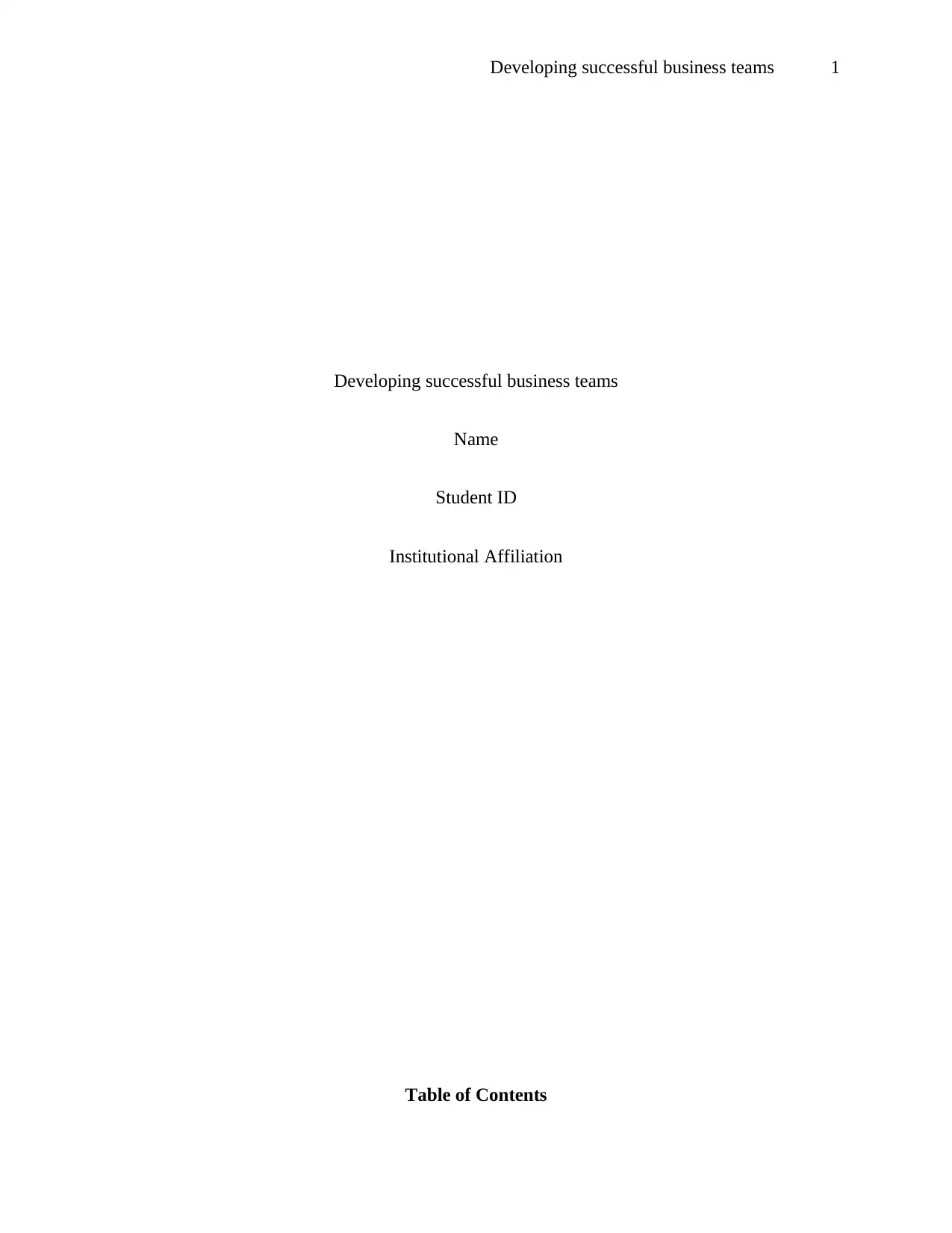
Developing successful business teams 1
Developing successful business teams
Name
Student ID
Institutional Affiliation
Table of Contents
Developing successful business teams
Name
Student ID
Institutional Affiliation
Table of Contents
Paraphrase This Document
Need a fresh take? Get an instant paraphrase of this document with our AI Paraphraser
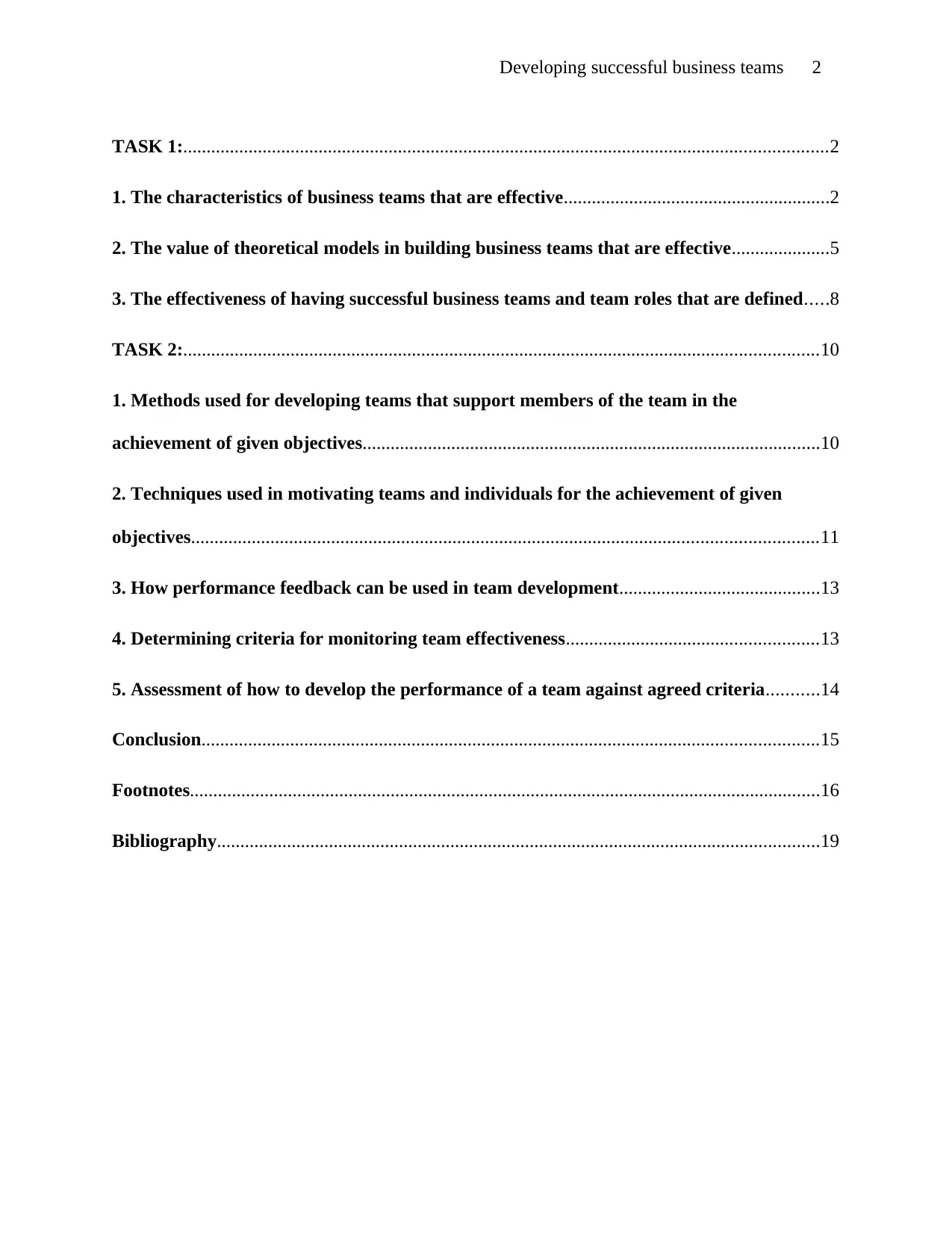
Developing successful business teams 2
TASK 1:..........................................................................................................................................2
1. The characteristics of business teams that are effective.........................................................2
2. The value of theoretical models in building business teams that are effective.....................5
3. The effectiveness of having successful business teams and team roles that are defined.....8
TASK 2:........................................................................................................................................10
1. Methods used for developing teams that support members of the team in the
achievement of given objectives..................................................................................................10
2. Techniques used in motivating teams and individuals for the achievement of given
objectives......................................................................................................................................11
3. How performance feedback can be used in team development...........................................13
4. Determining criteria for monitoring team effectiveness......................................................13
5. Assessment of how to develop the performance of a team against agreed criteria...........14
Conclusion....................................................................................................................................15
Footnotes.......................................................................................................................................16
Bibliography.................................................................................................................................19
TASK 1:..........................................................................................................................................2
1. The characteristics of business teams that are effective.........................................................2
2. The value of theoretical models in building business teams that are effective.....................5
3. The effectiveness of having successful business teams and team roles that are defined.....8
TASK 2:........................................................................................................................................10
1. Methods used for developing teams that support members of the team in the
achievement of given objectives..................................................................................................10
2. Techniques used in motivating teams and individuals for the achievement of given
objectives......................................................................................................................................11
3. How performance feedback can be used in team development...........................................13
4. Determining criteria for monitoring team effectiveness......................................................13
5. Assessment of how to develop the performance of a team against agreed criteria...........14
Conclusion....................................................................................................................................15
Footnotes.......................................................................................................................................16
Bibliography.................................................................................................................................19

Developing successful business teams 3
TASK 1:
1. The characteristics of business teams that are effective
According to Decuyper, Dochy and Van (2010 p.121) effective business teams have a
clear understanding of the objectives and goals of the team. Every team member should be in a
position of speaking for the team on their project’s progress when called upon1. Therefore, being
able to speak for the team requires the team members at Phillips to have a clear understanding of
the team’s goals and estimate whether they are making progress or not. In addition, effective
business teams at Phillips have shared values which means that they have a common desire to
succeed at what they do thus they have a common sense of purpose. Research by Tannenbaum
and Cerasoli (2013 p.237) shows that members in a particular team work independently and
interact to achieve the objectives of the team. In addition, they take responsibility collectively for
the achievement of shared objectives and aims2. Business teams at Phillips also have mutual
trust, which is an important aspect of open communication. All team members should have a will
of talking openly which only happens when team members have mutual trust. Mutual respect is
also a characteristic of effective business teams, which basically means that the team members at
Phillips respect each other as individuals and also respect the contribution of every member to
the performance of the team. Lack of mutual trust in business teams may jeopardize the team’s
effectiveness.
1 Katzenbach, Jon R., and Douglas K. Smith. The discipline of teams. Harvard Business Press,
2008.
2 Friedrich, Tamara L., William B. Vessey, Matthew J. Schuelke, Gregory A. Ruark, and Michael
D. Mumford. "A framework for understanding collective leadership: The selective utilization of
leader and team expertise within networks." The Leadership Quarterly 20, no. 6 (2009): 933-
958.
TASK 1:
1. The characteristics of business teams that are effective
According to Decuyper, Dochy and Van (2010 p.121) effective business teams have a
clear understanding of the objectives and goals of the team. Every team member should be in a
position of speaking for the team on their project’s progress when called upon1. Therefore, being
able to speak for the team requires the team members at Phillips to have a clear understanding of
the team’s goals and estimate whether they are making progress or not. In addition, effective
business teams at Phillips have shared values which means that they have a common desire to
succeed at what they do thus they have a common sense of purpose. Research by Tannenbaum
and Cerasoli (2013 p.237) shows that members in a particular team work independently and
interact to achieve the objectives of the team. In addition, they take responsibility collectively for
the achievement of shared objectives and aims2. Business teams at Phillips also have mutual
trust, which is an important aspect of open communication. All team members should have a will
of talking openly which only happens when team members have mutual trust. Mutual respect is
also a characteristic of effective business teams, which basically means that the team members at
Phillips respect each other as individuals and also respect the contribution of every member to
the performance of the team. Lack of mutual trust in business teams may jeopardize the team’s
effectiveness.
1 Katzenbach, Jon R., and Douglas K. Smith. The discipline of teams. Harvard Business Press,
2008.
2 Friedrich, Tamara L., William B. Vessey, Matthew J. Schuelke, Gregory A. Ruark, and Michael
D. Mumford. "A framework for understanding collective leadership: The selective utilization of
leader and team expertise within networks." The Leadership Quarterly 20, no. 6 (2009): 933-
958.
⊘ This is a preview!⊘
Do you want full access?
Subscribe today to unlock all pages.

Trusted by 1+ million students worldwide
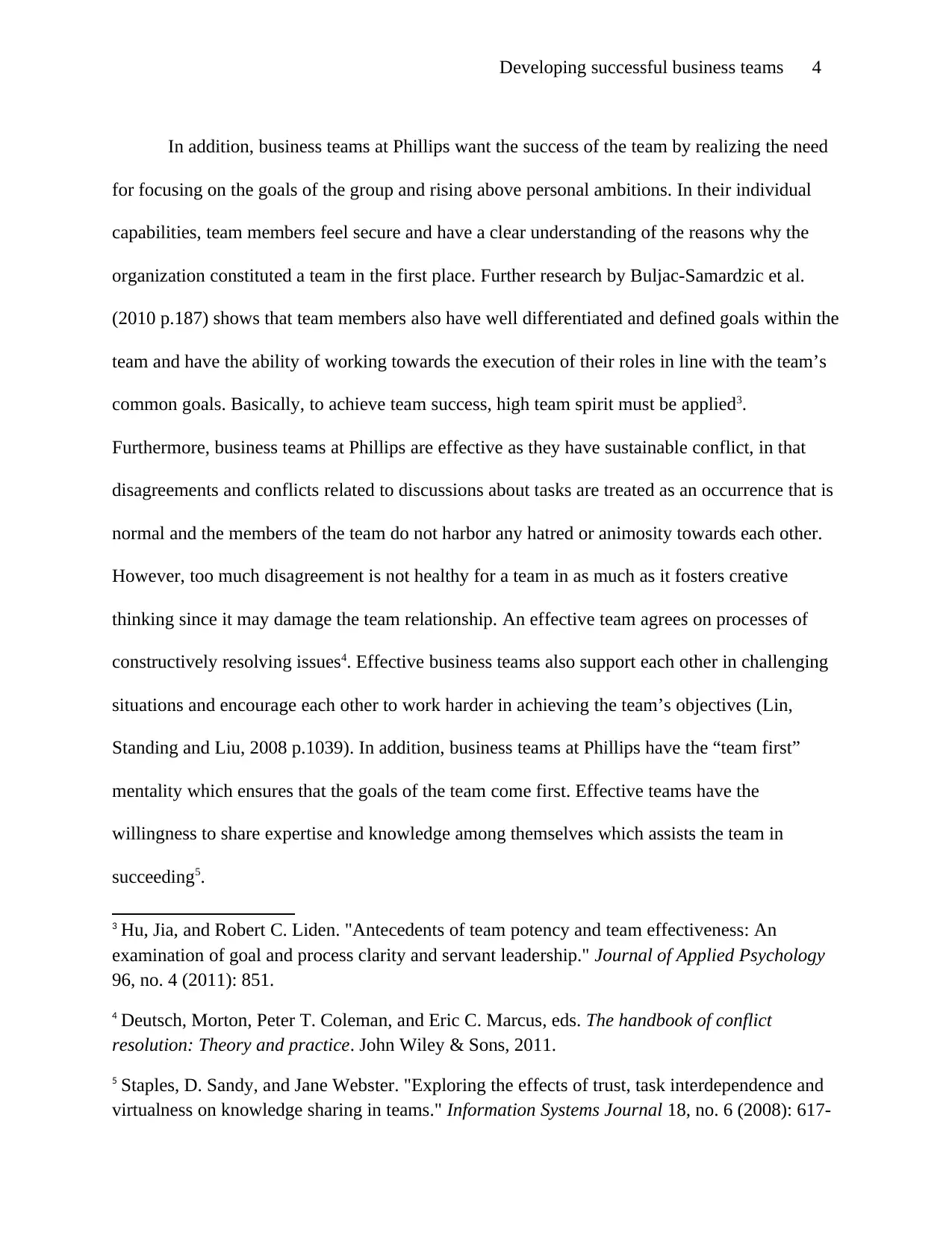
Developing successful business teams 4
In addition, business teams at Phillips want the success of the team by realizing the need
for focusing on the goals of the group and rising above personal ambitions. In their individual
capabilities, team members feel secure and have a clear understanding of the reasons why the
organization constituted a team in the first place. Further research by Buljac-Samardzic et al.
(2010 p.187) shows that team members also have well differentiated and defined goals within the
team and have the ability of working towards the execution of their roles in line with the team’s
common goals. Basically, to achieve team success, high team spirit must be applied3.
Furthermore, business teams at Phillips are effective as they have sustainable conflict, in that
disagreements and conflicts related to discussions about tasks are treated as an occurrence that is
normal and the members of the team do not harbor any hatred or animosity towards each other.
However, too much disagreement is not healthy for a team in as much as it fosters creative
thinking since it may damage the team relationship. An effective team agrees on processes of
constructively resolving issues4. Effective business teams also support each other in challenging
situations and encourage each other to work harder in achieving the team’s objectives (Lin,
Standing and Liu, 2008 p.1039). In addition, business teams at Phillips have the “team first”
mentality which ensures that the goals of the team come first. Effective teams have the
willingness to share expertise and knowledge among themselves which assists the team in
succeeding5.
3 Hu, Jia, and Robert C. Liden. "Antecedents of team potency and team effectiveness: An
examination of goal and process clarity and servant leadership." Journal of Applied Psychology
96, no. 4 (2011): 851.
4 Deutsch, Morton, Peter T. Coleman, and Eric C. Marcus, eds. The handbook of conflict
resolution: Theory and practice. John Wiley & Sons, 2011.
5 Staples, D. Sandy, and Jane Webster. "Exploring the effects of trust, task interdependence and
virtualness on knowledge sharing in teams." Information Systems Journal 18, no. 6 (2008): 617-
In addition, business teams at Phillips want the success of the team by realizing the need
for focusing on the goals of the group and rising above personal ambitions. In their individual
capabilities, team members feel secure and have a clear understanding of the reasons why the
organization constituted a team in the first place. Further research by Buljac-Samardzic et al.
(2010 p.187) shows that team members also have well differentiated and defined goals within the
team and have the ability of working towards the execution of their roles in line with the team’s
common goals. Basically, to achieve team success, high team spirit must be applied3.
Furthermore, business teams at Phillips are effective as they have sustainable conflict, in that
disagreements and conflicts related to discussions about tasks are treated as an occurrence that is
normal and the members of the team do not harbor any hatred or animosity towards each other.
However, too much disagreement is not healthy for a team in as much as it fosters creative
thinking since it may damage the team relationship. An effective team agrees on processes of
constructively resolving issues4. Effective business teams also support each other in challenging
situations and encourage each other to work harder in achieving the team’s objectives (Lin,
Standing and Liu, 2008 p.1039). In addition, business teams at Phillips have the “team first”
mentality which ensures that the goals of the team come first. Effective teams have the
willingness to share expertise and knowledge among themselves which assists the team in
succeeding5.
3 Hu, Jia, and Robert C. Liden. "Antecedents of team potency and team effectiveness: An
examination of goal and process clarity and servant leadership." Journal of Applied Psychology
96, no. 4 (2011): 851.
4 Deutsch, Morton, Peter T. Coleman, and Eric C. Marcus, eds. The handbook of conflict
resolution: Theory and practice. John Wiley & Sons, 2011.
5 Staples, D. Sandy, and Jane Webster. "Exploring the effects of trust, task interdependence and
virtualness on knowledge sharing in teams." Information Systems Journal 18, no. 6 (2008): 617-
Paraphrase This Document
Need a fresh take? Get an instant paraphrase of this document with our AI Paraphraser

Developing successful business teams 5
Furthermore, business teams at Phillips are engaged which means that every team
member participates in every project being undertaken by the team. Engaging members is
important as it gives them a feeling of making a strong contribution in the team. Effective
business teams also have an organizational connection which basically means that the rest of the
organization values the team hence there is increased motivation. Effective business teams have
adequate resources to facilitate their operations and meet their objectives and goals6. There is
also positive and open communication which assists in members being aware of developments
that are sensitive in their work. Team members ensure that they do not mock, reject or embarrass
a member for sharing their ideas on a particular subject. Business teams at Phillips also have a
feeling of belonging whereby members are strongly knitted and believe that they are part of the
team which gives them a sense of belonging. Mathieu and Rapp (2009 p.90) believe that
effective business teams have fun which ensures that they enjoy working together through
socializing outside of work and interacting on the job. Having fun ensures that team members
enjoy each other’s company and like each other.
2. The value of theoretical models in building business teams that are effective
Teamwork theories are organized ways of understanding various behaviors, procedures
and circumstances. The Bruce Tuckman’s Model of team stages was created in 1965, with many
companies applying the theory (Bonebright, 2010 p.113). The model consists of the forming,
640.
6 Bergiel, Blaise J., Erich B. Bergiel, and Phillip W. Balsmeier. "Nature of virtual teams: a
summary of their advantages and disadvantages." Management Research News 31, no. 2 (2008):
99-110.
Furthermore, business teams at Phillips are engaged which means that every team
member participates in every project being undertaken by the team. Engaging members is
important as it gives them a feeling of making a strong contribution in the team. Effective
business teams also have an organizational connection which basically means that the rest of the
organization values the team hence there is increased motivation. Effective business teams have
adequate resources to facilitate their operations and meet their objectives and goals6. There is
also positive and open communication which assists in members being aware of developments
that are sensitive in their work. Team members ensure that they do not mock, reject or embarrass
a member for sharing their ideas on a particular subject. Business teams at Phillips also have a
feeling of belonging whereby members are strongly knitted and believe that they are part of the
team which gives them a sense of belonging. Mathieu and Rapp (2009 p.90) believe that
effective business teams have fun which ensures that they enjoy working together through
socializing outside of work and interacting on the job. Having fun ensures that team members
enjoy each other’s company and like each other.
2. The value of theoretical models in building business teams that are effective
Teamwork theories are organized ways of understanding various behaviors, procedures
and circumstances. The Bruce Tuckman’s Model of team stages was created in 1965, with many
companies applying the theory (Bonebright, 2010 p.113). The model consists of the forming,
640.
6 Bergiel, Blaise J., Erich B. Bergiel, and Phillip W. Balsmeier. "Nature of virtual teams: a
summary of their advantages and disadvantages." Management Research News 31, no. 2 (2008):
99-110.

Developing successful business teams 6
storming, norming and performing stages and has been applied in many scenarios. Commonly,
the model is referred to as the “origin for successful team building”7.
Figure 1: Tuckman’s Model of Team Development
In his theory known as the Belbin’s theory of team roles, Belbin listed nine roles which all teams
should have. The roles included specialist, completer-finisher, implementer, team worker,
monitor evaluator, shaper, coordinator, resource investigator and plant (Batenburg, van-Walbeek
and Maur, 2013 p.907).
Figure 2: Belbin’s Team Roles
7 Bonebright, Denise A. "40 years of storming: a historical review of Tuckman's model of small
group development." Human Resource Development International 13, no. 1 (2010): 111-120.
storming, norming and performing stages and has been applied in many scenarios. Commonly,
the model is referred to as the “origin for successful team building”7.
Figure 1: Tuckman’s Model of Team Development
In his theory known as the Belbin’s theory of team roles, Belbin listed nine roles which all teams
should have. The roles included specialist, completer-finisher, implementer, team worker,
monitor evaluator, shaper, coordinator, resource investigator and plant (Batenburg, van-Walbeek
and Maur, 2013 p.907).
Figure 2: Belbin’s Team Roles
7 Bonebright, Denise A. "40 years of storming: a historical review of Tuckman's model of small
group development." Human Resource Development International 13, no. 1 (2010): 111-120.
⊘ This is a preview!⊘
Do you want full access?
Subscribe today to unlock all pages.

Trusted by 1+ million students worldwide
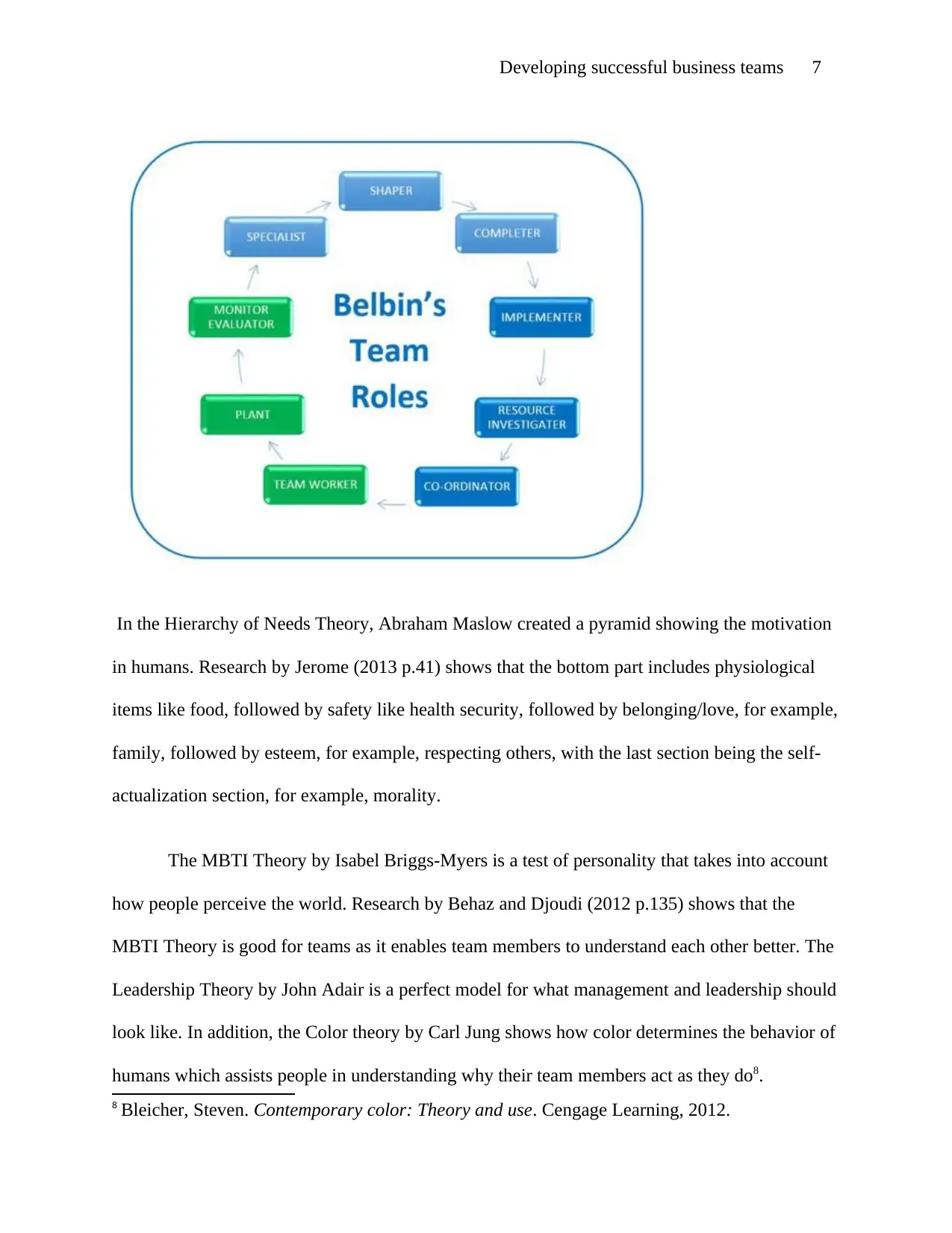
Developing successful business teams 7
In the Hierarchy of Needs Theory, Abraham Maslow created a pyramid showing the motivation
in humans. Research by Jerome (2013 p.41) shows that the bottom part includes physiological
items like food, followed by safety like health security, followed by belonging/love, for example,
family, followed by esteem, for example, respecting others, with the last section being the self-
actualization section, for example, morality.
The MBTI Theory by Isabel Briggs-Myers is a test of personality that takes into account
how people perceive the world. Research by Behaz and Djoudi (2012 p.135) shows that the
MBTI Theory is good for teams as it enables team members to understand each other better. The
Leadership Theory by John Adair is a perfect model for what management and leadership should
look like. In addition, the Color theory by Carl Jung shows how color determines the behavior of
humans which assists people in understanding why their team members act as they do8.
8 Bleicher, Steven. Contemporary color: Theory and use. Cengage Learning, 2012.
In the Hierarchy of Needs Theory, Abraham Maslow created a pyramid showing the motivation
in humans. Research by Jerome (2013 p.41) shows that the bottom part includes physiological
items like food, followed by safety like health security, followed by belonging/love, for example,
family, followed by esteem, for example, respecting others, with the last section being the self-
actualization section, for example, morality.
The MBTI Theory by Isabel Briggs-Myers is a test of personality that takes into account
how people perceive the world. Research by Behaz and Djoudi (2012 p.135) shows that the
MBTI Theory is good for teams as it enables team members to understand each other better. The
Leadership Theory by John Adair is a perfect model for what management and leadership should
look like. In addition, the Color theory by Carl Jung shows how color determines the behavior of
humans which assists people in understanding why their team members act as they do8.
8 Bleicher, Steven. Contemporary color: Theory and use. Cengage Learning, 2012.
Paraphrase This Document
Need a fresh take? Get an instant paraphrase of this document with our AI Paraphraser

Developing successful business teams 8
According to Hornsey (2008 p.207) Tajfel presented the social identity idea as a great way of
describing inter-group behavior through his theory on Social Identity. Moreover, Douglas
McGregor’s X and Y theory describes the motivation in humans, which is an important model
that employees and managers should familiarize themselves with (Kopelman, Prottas and Davis,
2008 p.261). The Strength Theory shows how people should continually work to achieve the best
teamwork and become strong, compared to how a muscle gets stronger when continuously
exercised. Lastly, the team analysis theory shows that, eventually, teams will fall apart thus one
will have to analyze and re-evaluate the situation to understand what went wrong. By keenly
understanding the theories on teamwork, organizations can gain the most from teams.
3. The effectiveness of having successful business teams and team roles that are defined
According to Thomas, Jacques, Adams and Kihneman-Wooten (2008 p.105) the team
roles concept is an integral part when building teams and getting the process of team building
right. Managers know the importance of building an effective team but few invest their time in
defining the team roles. The aspect has regrettably resulted in poor teams being made due to the
lack of genuinely tailored and substantive team roles. Observing behavior within the team tends
to fall into discernible and clear patterns reflecting both weaknesses manifesting under pressure
as well as the contributions made by an individual9. Dr. Meredith Belbin’s Team Role Model
which has been globally regarded as an effective facilitator in identifying existing patterns within
a team characterizes collective and individual teamwork. Belbin’s Team Role Model is useful for
9 Licorish, Sherlock, Anne Philpott, and Stephen G. MacDonell. "Supporting agile team
composition: A prototype tool for identifying personality (In) compatibilities." In Proceedings of
the 2009 ICSE Workshop on Cooperative and Human Aspects on Software Engineering, pp. 66-
73. IEEE Computer Society, 2009. Belbin, R. Meredith. Beyond the team. Routledge, 2012.
According to Hornsey (2008 p.207) Tajfel presented the social identity idea as a great way of
describing inter-group behavior through his theory on Social Identity. Moreover, Douglas
McGregor’s X and Y theory describes the motivation in humans, which is an important model
that employees and managers should familiarize themselves with (Kopelman, Prottas and Davis,
2008 p.261). The Strength Theory shows how people should continually work to achieve the best
teamwork and become strong, compared to how a muscle gets stronger when continuously
exercised. Lastly, the team analysis theory shows that, eventually, teams will fall apart thus one
will have to analyze and re-evaluate the situation to understand what went wrong. By keenly
understanding the theories on teamwork, organizations can gain the most from teams.
3. The effectiveness of having successful business teams and team roles that are defined
According to Thomas, Jacques, Adams and Kihneman-Wooten (2008 p.105) the team
roles concept is an integral part when building teams and getting the process of team building
right. Managers know the importance of building an effective team but few invest their time in
defining the team roles. The aspect has regrettably resulted in poor teams being made due to the
lack of genuinely tailored and substantive team roles. Observing behavior within the team tends
to fall into discernible and clear patterns reflecting both weaknesses manifesting under pressure
as well as the contributions made by an individual9. Dr. Meredith Belbin’s Team Role Model
which has been globally regarded as an effective facilitator in identifying existing patterns within
a team characterizes collective and individual teamwork. Belbin’s Team Role Model is useful for
9 Licorish, Sherlock, Anne Philpott, and Stephen G. MacDonell. "Supporting agile team
composition: A prototype tool for identifying personality (In) compatibilities." In Proceedings of
the 2009 ICSE Workshop on Cooperative and Human Aspects on Software Engineering, pp. 66-
73. IEEE Computer Society, 2009. Belbin, R. Meredith. Beyond the team. Routledge, 2012.
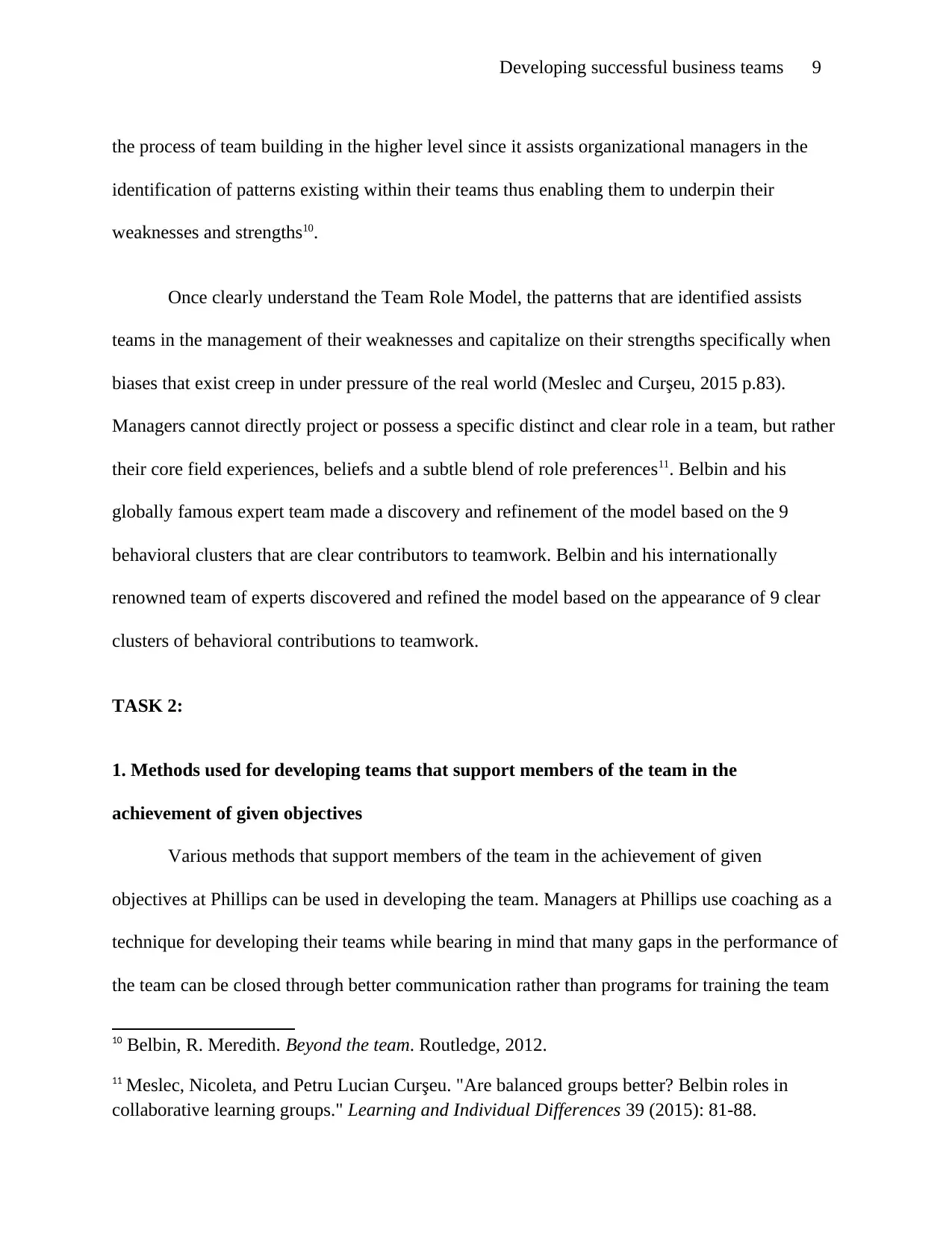
Developing successful business teams 9
the process of team building in the higher level since it assists organizational managers in the
identification of patterns existing within their teams thus enabling them to underpin their
weaknesses and strengths10.
Once clearly understand the Team Role Model, the patterns that are identified assists
teams in the management of their weaknesses and capitalize on their strengths specifically when
biases that exist creep in under pressure of the real world (Meslec and Curşeu, 2015 p.83).
Managers cannot directly project or possess a specific distinct and clear role in a team, but rather
their core field experiences, beliefs and a subtle blend of role preferences11. Belbin and his
globally famous expert team made a discovery and refinement of the model based on the 9
behavioral clusters that are clear contributors to teamwork. Belbin and his internationally
renowned team of experts discovered and refined the model based on the appearance of 9 clear
clusters of behavioral contributions to teamwork.
TASK 2:
1. Methods used for developing teams that support members of the team in the
achievement of given objectives
Various methods that support members of the team in the achievement of given
objectives at Phillips can be used in developing the team. Managers at Phillips use coaching as a
technique for developing their teams while bearing in mind that many gaps in the performance of
the team can be closed through better communication rather than programs for training the team
10 Belbin, R. Meredith. Beyond the team. Routledge, 2012.
11 Meslec, Nicoleta, and Petru Lucian Curşeu. "Are balanced groups better? Belbin roles in
collaborative learning groups." Learning and Individual Differences 39 (2015): 81-88.
the process of team building in the higher level since it assists organizational managers in the
identification of patterns existing within their teams thus enabling them to underpin their
weaknesses and strengths10.
Once clearly understand the Team Role Model, the patterns that are identified assists
teams in the management of their weaknesses and capitalize on their strengths specifically when
biases that exist creep in under pressure of the real world (Meslec and Curşeu, 2015 p.83).
Managers cannot directly project or possess a specific distinct and clear role in a team, but rather
their core field experiences, beliefs and a subtle blend of role preferences11. Belbin and his
globally famous expert team made a discovery and refinement of the model based on the 9
behavioral clusters that are clear contributors to teamwork. Belbin and his internationally
renowned team of experts discovered and refined the model based on the appearance of 9 clear
clusters of behavioral contributions to teamwork.
TASK 2:
1. Methods used for developing teams that support members of the team in the
achievement of given objectives
Various methods that support members of the team in the achievement of given
objectives at Phillips can be used in developing the team. Managers at Phillips use coaching as a
technique for developing their teams while bearing in mind that many gaps in the performance of
the team can be closed through better communication rather than programs for training the team
10 Belbin, R. Meredith. Beyond the team. Routledge, 2012.
11 Meslec, Nicoleta, and Petru Lucian Curşeu. "Are balanced groups better? Belbin roles in
collaborative learning groups." Learning and Individual Differences 39 (2015): 81-88.
⊘ This is a preview!⊘
Do you want full access?
Subscribe today to unlock all pages.

Trusted by 1+ million students worldwide
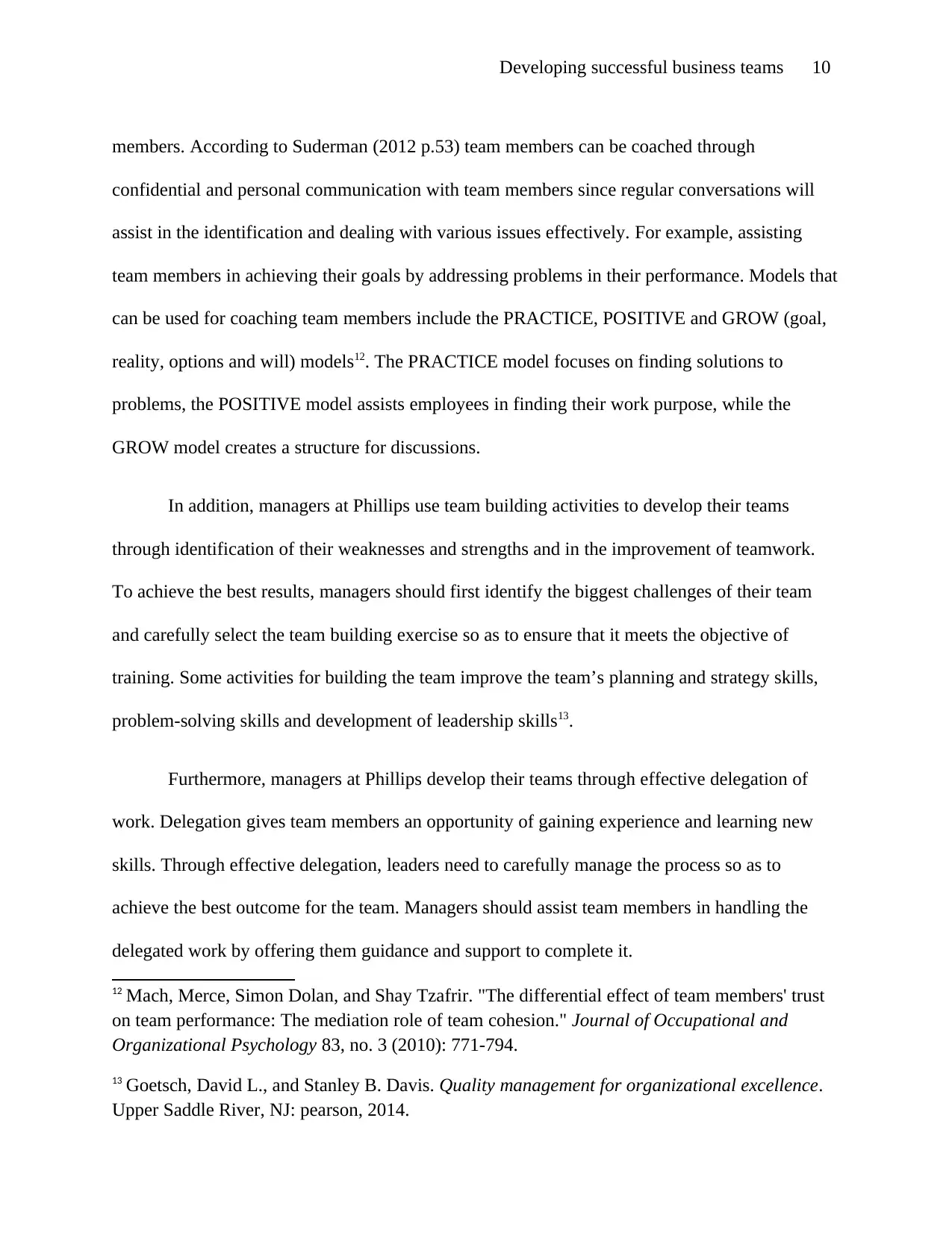
Developing successful business teams 10
members. According to Suderman (2012 p.53) team members can be coached through
confidential and personal communication with team members since regular conversations will
assist in the identification and dealing with various issues effectively. For example, assisting
team members in achieving their goals by addressing problems in their performance. Models that
can be used for coaching team members include the PRACTICE, POSITIVE and GROW (goal,
reality, options and will) models12. The PRACTICE model focuses on finding solutions to
problems, the POSITIVE model assists employees in finding their work purpose, while the
GROW model creates a structure for discussions.
In addition, managers at Phillips use team building activities to develop their teams
through identification of their weaknesses and strengths and in the improvement of teamwork.
To achieve the best results, managers should first identify the biggest challenges of their team
and carefully select the team building exercise so as to ensure that it meets the objective of
training. Some activities for building the team improve the team’s planning and strategy skills,
problem-solving skills and development of leadership skills13.
Furthermore, managers at Phillips develop their teams through effective delegation of
work. Delegation gives team members an opportunity of gaining experience and learning new
skills. Through effective delegation, leaders need to carefully manage the process so as to
achieve the best outcome for the team. Managers should assist team members in handling the
delegated work by offering them guidance and support to complete it.
12 Mach, Merce, Simon Dolan, and Shay Tzafrir. "The differential effect of team members' trust
on team performance: The mediation role of team cohesion." Journal of Occupational and
Organizational Psychology 83, no. 3 (2010): 771-794.
13 Goetsch, David L., and Stanley B. Davis. Quality management for organizational excellence.
Upper Saddle River, NJ: pearson, 2014.
members. According to Suderman (2012 p.53) team members can be coached through
confidential and personal communication with team members since regular conversations will
assist in the identification and dealing with various issues effectively. For example, assisting
team members in achieving their goals by addressing problems in their performance. Models that
can be used for coaching team members include the PRACTICE, POSITIVE and GROW (goal,
reality, options and will) models12. The PRACTICE model focuses on finding solutions to
problems, the POSITIVE model assists employees in finding their work purpose, while the
GROW model creates a structure for discussions.
In addition, managers at Phillips use team building activities to develop their teams
through identification of their weaknesses and strengths and in the improvement of teamwork.
To achieve the best results, managers should first identify the biggest challenges of their team
and carefully select the team building exercise so as to ensure that it meets the objective of
training. Some activities for building the team improve the team’s planning and strategy skills,
problem-solving skills and development of leadership skills13.
Furthermore, managers at Phillips develop their teams through effective delegation of
work. Delegation gives team members an opportunity of gaining experience and learning new
skills. Through effective delegation, leaders need to carefully manage the process so as to
achieve the best outcome for the team. Managers should assist team members in handling the
delegated work by offering them guidance and support to complete it.
12 Mach, Merce, Simon Dolan, and Shay Tzafrir. "The differential effect of team members' trust
on team performance: The mediation role of team cohesion." Journal of Occupational and
Organizational Psychology 83, no. 3 (2010): 771-794.
13 Goetsch, David L., and Stanley B. Davis. Quality management for organizational excellence.
Upper Saddle River, NJ: pearson, 2014.
Paraphrase This Document
Need a fresh take? Get an instant paraphrase of this document with our AI Paraphraser

Developing successful business teams 11
Moreover, managing talent is an effective method for team development14. Managers
should identify team members with specific talents, assist in retaining them and build their
capabilities (Naqvi, 2009 p.85). The managers at Phillips work in conjunction with the human
resource department to support the development of the skills of team members with an effective
system for performance management.
2. Techniques used in motivating teams and individuals for the achievement of given
objectives
There are several techniques that can be used for motivating teams and individuals in the
achievement of given objectives. Offering financial rewards to well-performing employees is
important in that the employee feels that they are being paid for what they are worth and
motivates them to work harder15. When setting the salaries of employees, it is important to ensure
that they match with what other organizations in the geographic area or industry are paying the
employees serving in the same capacity (Aguinis and Kraiger, 2009 p.460). Paying employees
well ensures that they are retained in the company and would not think of shifting to other
companies due to minor salary increments.
Managers at Phillips motivate employees through recognition of their efforts and
achievements. Recognition could be in the form of promotions, gift cards, bonuses or certificates
which gives the employee the motivation to put more effort and being the best they can in their
roles and responsibilities in the workplace. In addition, offering employees a good environment
14 Cappelli, Peter. "Talent management for the twenty-first century." Harvard business review 86,
no. 3 (2008): 74.
15 Lazar, Ioan, Codruta Osoian, and Patricia Ratiu. "The role of work-life balance practices in
order to improve organizational performance." European Research Studies 13, no. 1 (2010): 201.
Moreover, managing talent is an effective method for team development14. Managers
should identify team members with specific talents, assist in retaining them and build their
capabilities (Naqvi, 2009 p.85). The managers at Phillips work in conjunction with the human
resource department to support the development of the skills of team members with an effective
system for performance management.
2. Techniques used in motivating teams and individuals for the achievement of given
objectives
There are several techniques that can be used for motivating teams and individuals in the
achievement of given objectives. Offering financial rewards to well-performing employees is
important in that the employee feels that they are being paid for what they are worth and
motivates them to work harder15. When setting the salaries of employees, it is important to ensure
that they match with what other organizations in the geographic area or industry are paying the
employees serving in the same capacity (Aguinis and Kraiger, 2009 p.460). Paying employees
well ensures that they are retained in the company and would not think of shifting to other
companies due to minor salary increments.
Managers at Phillips motivate employees through recognition of their efforts and
achievements. Recognition could be in the form of promotions, gift cards, bonuses or certificates
which gives the employee the motivation to put more effort and being the best they can in their
roles and responsibilities in the workplace. In addition, offering employees a good environment
14 Cappelli, Peter. "Talent management for the twenty-first century." Harvard business review 86,
no. 3 (2008): 74.
15 Lazar, Ioan, Codruta Osoian, and Patricia Ratiu. "The role of work-life balance practices in
order to improve organizational performance." European Research Studies 13, no. 1 (2010): 201.
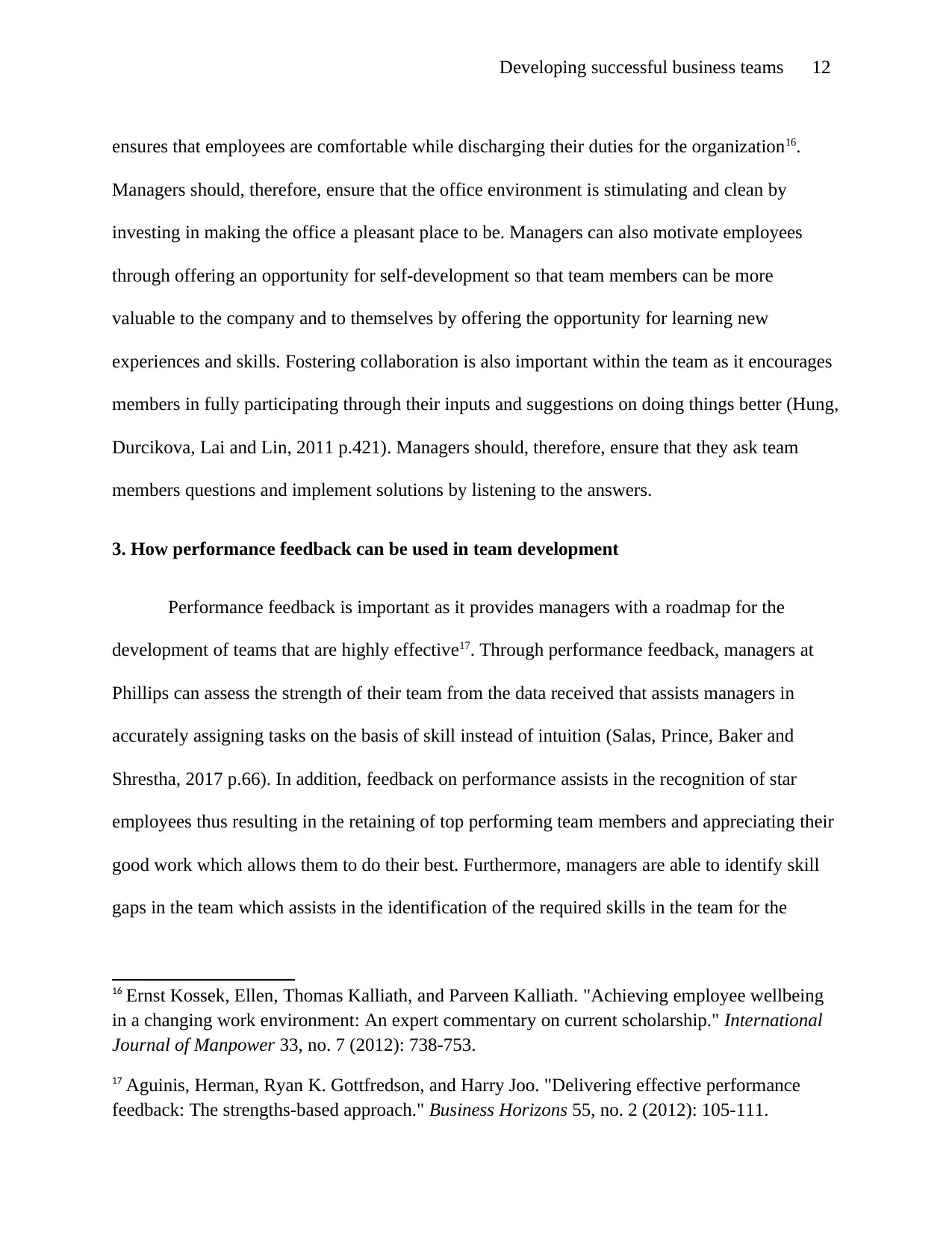
Developing successful business teams 12
ensures that employees are comfortable while discharging their duties for the organization16.
Managers should, therefore, ensure that the office environment is stimulating and clean by
investing in making the office a pleasant place to be. Managers can also motivate employees
through offering an opportunity for self-development so that team members can be more
valuable to the company and to themselves by offering the opportunity for learning new
experiences and skills. Fostering collaboration is also important within the team as it encourages
members in fully participating through their inputs and suggestions on doing things better (Hung,
Durcikova, Lai and Lin, 2011 p.421). Managers should, therefore, ensure that they ask team
members questions and implement solutions by listening to the answers.
3. How performance feedback can be used in team development
Performance feedback is important as it provides managers with a roadmap for the
development of teams that are highly effective17. Through performance feedback, managers at
Phillips can assess the strength of their team from the data received that assists managers in
accurately assigning tasks on the basis of skill instead of intuition (Salas, Prince, Baker and
Shrestha, 2017 p.66). In addition, feedback on performance assists in the recognition of star
employees thus resulting in the retaining of top performing team members and appreciating their
good work which allows them to do their best. Furthermore, managers are able to identify skill
gaps in the team which assists in the identification of the required skills in the team for the
16 Ernst Kossek, Ellen, Thomas Kalliath, and Parveen Kalliath. "Achieving employee wellbeing
in a changing work environment: An expert commentary on current scholarship." International
Journal of Manpower 33, no. 7 (2012): 738-753.
17 Aguinis, Herman, Ryan K. Gottfredson, and Harry Joo. "Delivering effective performance
feedback: The strengths-based approach." Business Horizons 55, no. 2 (2012): 105-111.
ensures that employees are comfortable while discharging their duties for the organization16.
Managers should, therefore, ensure that the office environment is stimulating and clean by
investing in making the office a pleasant place to be. Managers can also motivate employees
through offering an opportunity for self-development so that team members can be more
valuable to the company and to themselves by offering the opportunity for learning new
experiences and skills. Fostering collaboration is also important within the team as it encourages
members in fully participating through their inputs and suggestions on doing things better (Hung,
Durcikova, Lai and Lin, 2011 p.421). Managers should, therefore, ensure that they ask team
members questions and implement solutions by listening to the answers.
3. How performance feedback can be used in team development
Performance feedback is important as it provides managers with a roadmap for the
development of teams that are highly effective17. Through performance feedback, managers at
Phillips can assess the strength of their team from the data received that assists managers in
accurately assigning tasks on the basis of skill instead of intuition (Salas, Prince, Baker and
Shrestha, 2017 p.66). In addition, feedback on performance assists in the recognition of star
employees thus resulting in the retaining of top performing team members and appreciating their
good work which allows them to do their best. Furthermore, managers are able to identify skill
gaps in the team which assists in the identification of the required skills in the team for the
16 Ernst Kossek, Ellen, Thomas Kalliath, and Parveen Kalliath. "Achieving employee wellbeing
in a changing work environment: An expert commentary on current scholarship." International
Journal of Manpower 33, no. 7 (2012): 738-753.
17 Aguinis, Herman, Ryan K. Gottfredson, and Harry Joo. "Delivering effective performance
feedback: The strengths-based approach." Business Horizons 55, no. 2 (2012): 105-111.
⊘ This is a preview!⊘
Do you want full access?
Subscribe today to unlock all pages.

Trusted by 1+ million students worldwide
1 out of 21
Related Documents
Your All-in-One AI-Powered Toolkit for Academic Success.
+13062052269
info@desklib.com
Available 24*7 on WhatsApp / Email
![[object Object]](/_next/static/media/star-bottom.7253800d.svg)
Unlock your academic potential
Copyright © 2020–2025 A2Z Services. All Rights Reserved. Developed and managed by ZUCOL.


